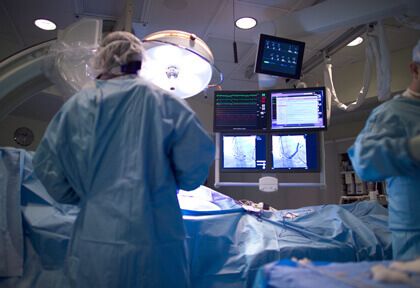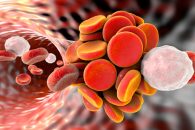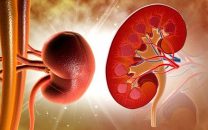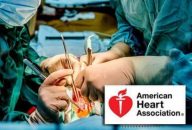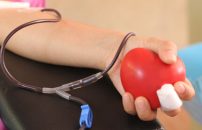1) Balloon Angioplasty: A Reasonable Plan B for Chronic Thromboembolic Hypertension Thromboembolic pulmonary hypertension is caused by pulmonary artery stenosis caused by organized thrombi. The only treatment potentially healing for this disease is surgical thrombectomy. However, patients with lesions in very peripheral branches or high surgical risk patients with comorbidities might benefit from a plan B,…
DKCRUSH-V: Left Main, Not Just Another Bifurcation
Cardiac Artery Bypass Graft Surgery has been shown more effective than percutaneous coronary intervention (basically because it renders lower revascularization rate) in patients with severe left main bifurcation lesions receiving 1st generation drug eluting stents. This is why the 2014 American guidelines recommend CABG for most patients. But the EXCEL and the NOBLE trials brought back hope to…
Ischemic and Bleeding Risk After Primary Angioplasty
Patients with ST-segment elevation myocardial infarction who undergo primary angioplasty are at high risk for both ischemic and bleeding events, which affect significantly both morbidity and mortality. An optimal selection of antithrombotic therapies in terms of strength and duration must take into account the timing for the procedure, since the risk for these complications may…
Angioplasty Complexity May Define the Duration of Dual Antiplatelet Therapy
The DAPT study concluded that continued thienopyridine plus aspirin beyond a year after coronary angioplasty is associated with a decrease in the rate of stent thrombosis and major cardiovascular events. In contrast, there is a significant increase in moderate to severe bleeding when compared with continued aspirin alone. Based on the outcomes of this and…
PRESERVE: IV Bicarbonate and Oral N-Acetylcysteine Do Not Prevent Contrast-Associated Acute Kidney Injury
Use of IV bicarbonate instead of saline and administration of oral N-acetylcysteine are not effective strategies for preventing contrast-associated acute kidney injury in patients with chronic kidney disease undergoing angiography, according to the randomized PRESERVE trial that was presented at the AHA 2017 Scientific Sessions and published simultaneously in the New England Journal of Medicine…
NCDR ACTION Registry: Anticoagulated Patients with No Higher Risk of Bleeding in Emergency Procedures
Patients with a history of atrial fibrillation treated with warfarin or any of the new direct oral anticoagulants undergoing acute myocardial infarction do not present higher risk of bleeding when receiving angiography or angioplasty. In fact, this subgroup of anticoagulated patients showed lower in-hospital mortality than the control group. After analyzing 6471 patients undergoing ST elevation MI…
TRICS III: Restrictive Transfusion Was Noninferior to Liberal Use in Patients Who Undergo Cardiac Surgery
A large study conducted in 19 countries has found that a policy of restrictive red-cell transfusion during cardiac surgery is just as safe and effective as more liberal policies. TRICS III enrolled 5243 patients and was presented at the American Heart Association (AHA) Scientific Sessions and published simultaneously in the New England Journal of Medicine (NEJM). Patients were…
Study Confirms Lead Shields Protect Cath Lab Staff from Radiation Exposure
The recent publication of several reports on risk of cataract, left sided brain tumors, subclinical atherosclerosis and chromosome damage among interventional cardiologists has raised increasing concerns about radiation exposure in the cath lab. Recognizing these risks has created a demand of these new forms of protection. Unfortunately, these have mainly been focused on the main operator,…
Though on the Rise, the Transradial Approach to Primary PCI Remains Underused
There is evidence to support the use of the transradial approach to coronary angioplasty. Several randomized studies have shown reduced bleeding and vascular complications when adopted, compared against patients treated with the femoral approach. There are also studies and meta-analysis suggesting that, in the context of primary PCI, the benefit would be even bigger, with significant events…
Important Study Detects Radiation-Induced DNA Damage in Operators After an Endovascular Procedure
In recent years, we have seen (both as witnesses and actors) an exponential increase in the number of fluoroscopically-guided cardiovascular interventions carried out by interventional cardiologists, electrophysiologists, and vascular surgeons. Not long ago, most pathologies treated with these procedures were the exclusive domain of open surgery. Now, a large number of patients can be treated…
TCT 2017 | FAME 2 at 3 Years: Better Results with Angioplasty and at a Cost Similar to Medical Treatment
Courtesy of SBHCI. Angioplasty in patients with chronic stable angina and functionally significant lesions improves clinical outcomes and quality of life over the long term, as compared with optimal medical therapy alone. Furthermore, the invasive approach becomes more cost-effective as the years go by. Previously, FAME 2 had shown that angioplasty was initially more expensive, but…
